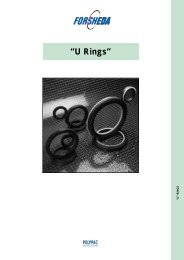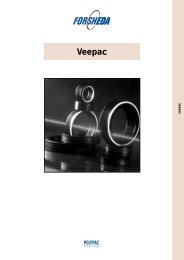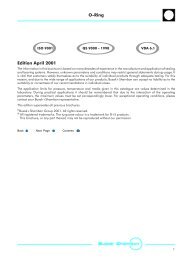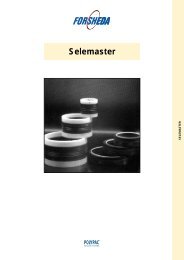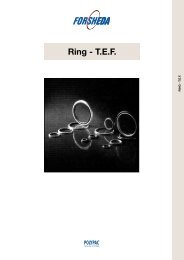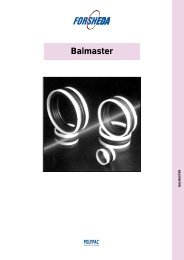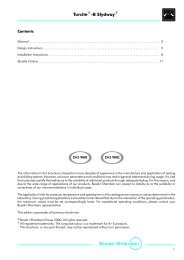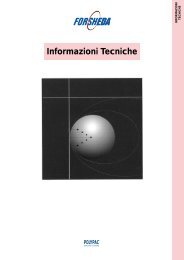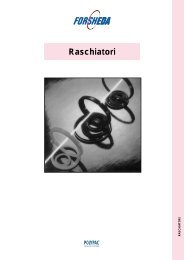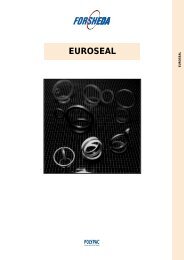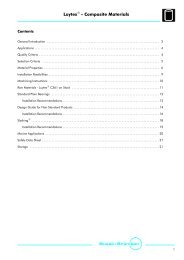Rotary Seals - Dilanda.it
Rotary Seals - Dilanda.it
Rotary Seals - Dilanda.it
You also want an ePaper? Increase the reach of your titles
YUMPU automatically turns print PDFs into web optimized ePapers that Google loves.
Radial Oil Seal<br />
Sealing element<br />
Materials<br />
The demands made on the material must take into account<br />
the environmental cond<strong>it</strong>ions and the function of the seal.<br />
Some of the requirements associated w<strong>it</strong>h environmental<br />
considerations are:<br />
- Good chemical resistance<br />
- Good resistance to heat and low temperature<br />
- Good resistance to ozone and weathering<br />
The functional demands include:<br />
- High resistance to wear<br />
- Low friction<br />
- Low compression set<br />
- Good elastic<strong>it</strong>y<br />
In add<strong>it</strong>ion, cost considerations render good processabil<strong>it</strong>y<br />
a desirable feature. No material is available today which<br />
satisfies all these requirements. The choice of materials is<br />
therefore always a compromise between the relative<br />
significances of the factors involved.<br />
Type and designations of materials<br />
N<strong>it</strong>rile rubber<br />
Acrylic rubber<br />
Silicone rubber<br />
Fluorinated rubber<br />
Hydrogenated N<strong>it</strong>rile rubber<br />
(NBR)<br />
(ACM)<br />
(VMQ)<br />
(FKM)<br />
(HNBR)<br />
A further development of the N<strong>it</strong>rile rubber has led to the<br />
so called hydrogenated N<strong>it</strong>rile rubber (HNBR). The heat<br />
and ozone resistance is significantly better. This material<br />
can replace Acrylic rubber and in certain cases also<br />
Fluorinated rubber. In order to satisfy the wide range of<br />
demands made on seals, a special compos<strong>it</strong>ion has been<br />
developed for each type of rubber. Other compos<strong>it</strong>ions are<br />
also available to meet some extreme requirements.<br />
Table V<br />
Material recommendations<br />
Materials<br />
for sealing common media<br />
Acrylon<strong>it</strong>rile<br />
Butadiene<br />
Rubber<br />
NBR<br />
Fluoro carbon<br />
Rubber<br />
FKM<br />
Material designation<br />
Polyacrylate<br />
Rubber<br />
ACM<br />
Material Abbreviation<br />
Silicone<br />
Rubber<br />
VMQ<br />
Hydrogenated<br />
Acrylon<strong>it</strong>rile<br />
Butadien Rubber<br />
HNBR<br />
N V A S H<br />
Max. permissible constant temperature (°C)<br />
Engine oils 100 170 125 150 130<br />
Transmission oils 80 150 125 130 110<br />
Mineral<br />
fluids<br />
Flame retardant<br />
hydraulic fluids<br />
(VDMA 24317)<br />
(VDMA 24320)<br />
Other media<br />
Hypoid transmission oils 80 150 125 - - 110<br />
ATF oils 100 170 125 - - 130<br />
Hydraulic fluids (DIN 51524) 90 150 120 - - 130<br />
Greases 90 - - - - - - 100<br />
Oil-water emulsion 70 - - - - 60 70<br />
Water-oil emulsion 70 - - - - 60 70<br />
Aqueous solutions 70 - - - - - - 70<br />
Water-free fluids - - 150 - - - - - -<br />
Fuel oils 90 - - - - - - 100<br />
Water 90 100 - - - - 100<br />
Lyes 90 100 - - - - 100<br />
Air 100 200 150 200 130<br />
Due to the different configurations of the media, the<br />
above-mentioned temperature ranges are for guidance<br />
only. Depending on the medium, significant deviations may<br />
occur.<br />
Latest information available at www.busakshamban.com<br />
Ed<strong>it</strong>ion April 2006<br />
19



